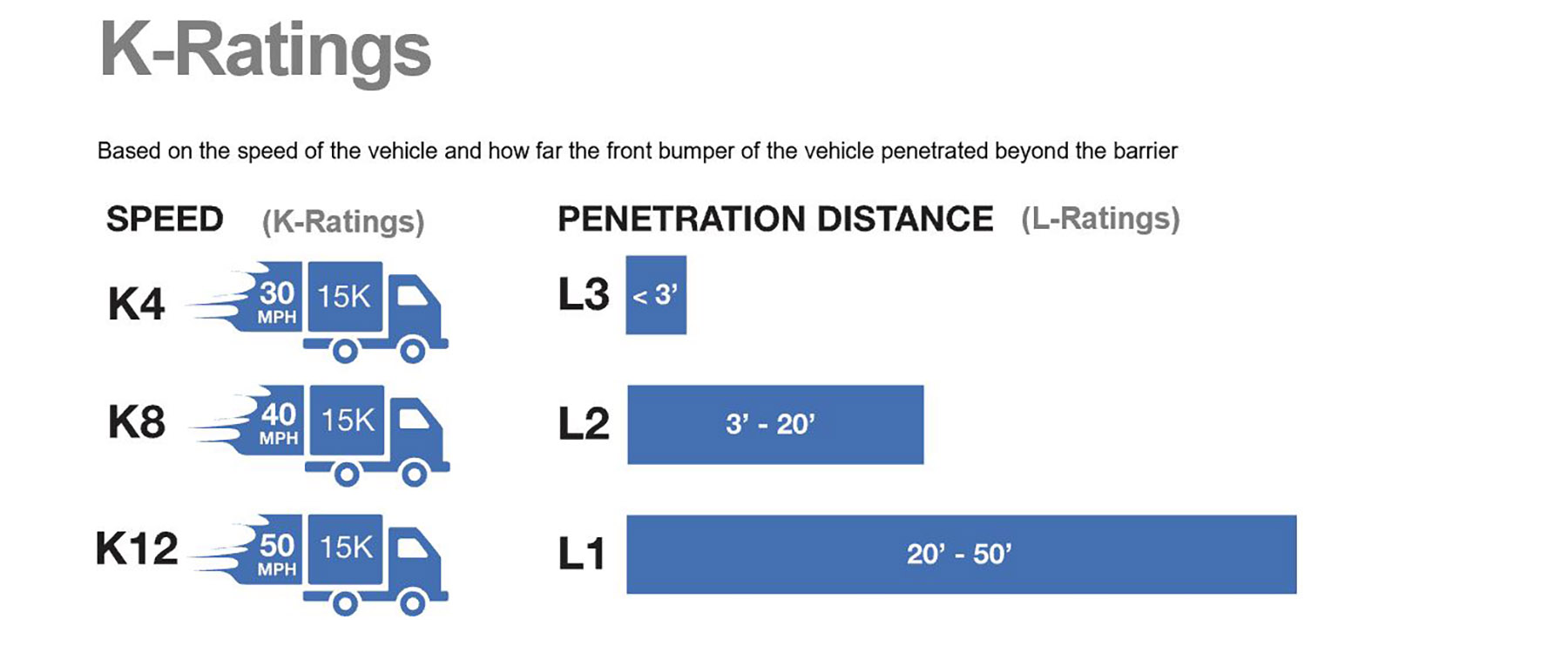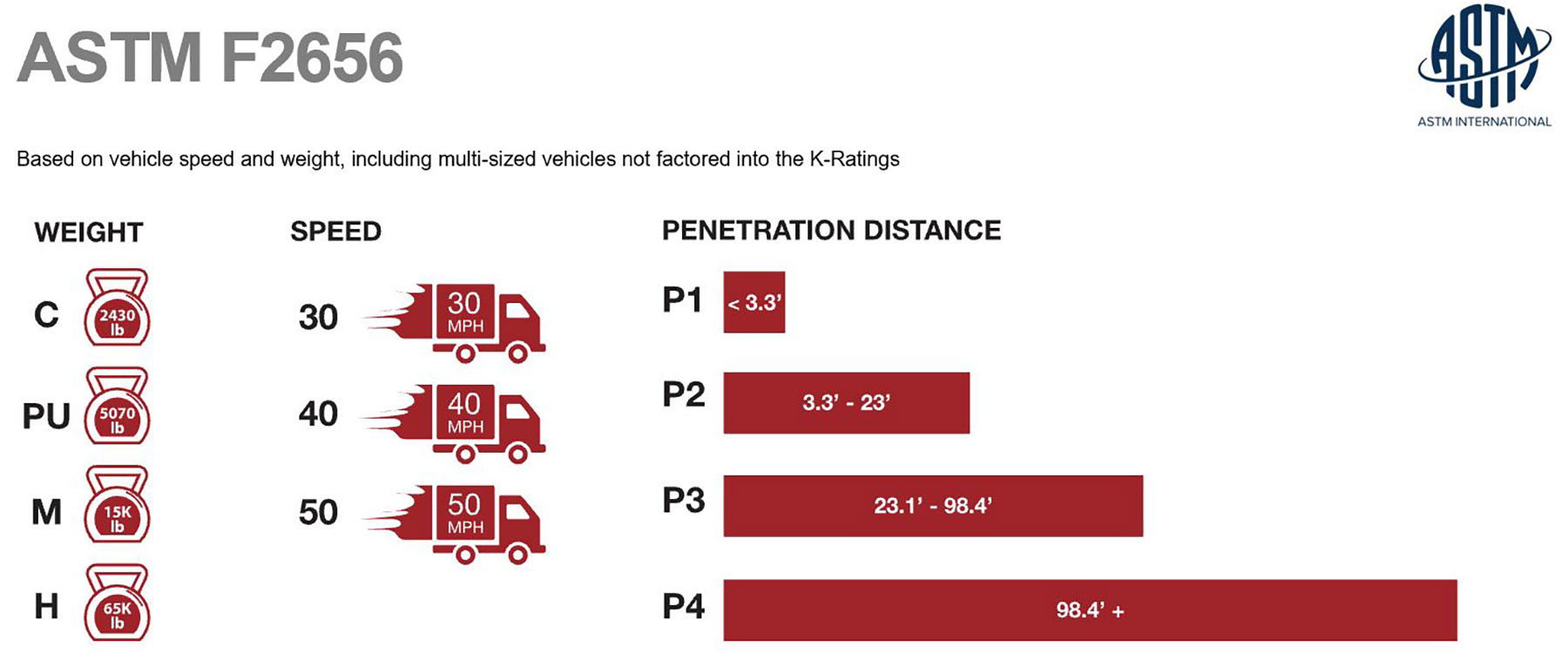Understanding Crash Ratings
Understanding crash ratings is essential for anyone selecting a hostile vehicle mitigation (HVM) solution. These ratings help determine how well a barrier can stop a vehicle based on its weight, speed, and how far it penetrates past the barrier. Without this knowledge, it's easy to over- or under-specify a system, which can lead to inadequate security or unnecessary cost. This guide breaks down the key standards and rating systems so you can confidently choose the right anti-ram or vehicle barrier for your application.
There are two main crash rating systems used today: the legacy K-Rating developed by the U.S. Department of Defense and the more modern ASTM F2656 standard. Each rating system categorizes crash performance using three main variables: vehicle weight, impact speed, and penetration distance. Let's explore what each of these metrics means and why they matter.
Why Crash Ratings Matter for HVM
Understanding crash ratings isn't just about checking specs, it's about designing a system that truly meets your safety and operational needs. A government building, for instance, may require an M50 P1 barrier due to its high risk of targeted attacks, while a corporate office might only need a PU30 P2 for traffic redirection. Choosing the wrong rating can compromise safety or lead to overbuilding and unnecessary expense.
When selecting a barrier, it's important to evaluate the potential threat level, vehicle types likely to be encountered, available stopping distance, and whether the environment supports surface-mounted or in-ground installations. Consulting with a professional who understands crash ratings and vehicle dynamics can also make a significant difference in successful implementation.
K-Rating (Department of Defense Standard)
The K-Rating system was created by the U.S. Department of State in the 1980s and later adopted by the Department of Defense to evaluate anti-ram barriers. It primarily focuses on how effectively a barrier stops a 15,000-pound (medium-duty truck) vehicle at different speeds. The system classifies impact speed as follows:
- K4: 30 mph impact
- K8: 40 mph impact
- K12: 50 mph impact
To complement speed, K-Ratings also include an L-Rating, which measures how far the vehicle's front bumper penetrates beyond the barrier:
- L3: Penetration under 3 feet
- L2: Penetration between 3 and 20 feet
- L1: Penetration between 20 and 50 feet
Although the K-Rating is somewhat outdated, it is still used for legacy systems and can be helpful when evaluating older barriers.
ASTM F2656 (Current Crash Test Standard)
ASTM F2656 is the current industry standard for testing vehicle barriers. Developed by the American Society for Testing and Materials, this rating system expands upon the older K-Rating by providing more detailed classifications for vehicle types, impact speeds, and penetration distances. It's often referred to as the "M-Rating" system, where "M" stands for a 15,000 lb. vehicle.
Here's how the ASTM system breaks down:
- Vehicle Types: C (small car), PU (pickup truck), M (medium truck, 15,000 lbs.), H (heavy vehicle)
- Impact Speeds: 30 mph, 40 mph, or 50 mph
- Penetration Ratings:
In the context of crash ratings, penetration distance refers to how far a vehicle continues to move *beyond the barrier* after it impacts it. It measures the distance from the backside (protected side) of the barrier to the point where the vehicle's front bumper comes to a complete stop. This metric is critical in determining how effective a barrier is at preventing vehicle intrusion into secure areas.
For example, a penetration rating of P1 (less than 3.3 feet) means the vehicle is brought to a complete stop just a few feet past the barrier, minimizing the chance of it reaching sensitive or crowded zones. A P4 rating, on the other hand, indicates the vehicle traveled more than 98.4 feet past the barrier, enough to endanger whatever lies behind it.
It's important to note that a vehicle may still be heavily damaged or stopped by the barrier itself, but if the momentum carries it too far past the impact point, the barrier may fail to protect the intended space. That's why penetration distance is just as important as impact speed or vehicle weight in determining the right hostile vehicle mitigation solution.
- P1: Penetration less than 3.3 feet
- P2: 3.31 - 23.0 feet
- P3: 23.1 - 98.4 feet
- P4: greater than 98.4 feet
FAQ: Hostile Vehicle Mitigation & Crash Ratings
- Q: What does "M50 P1" mean?
A: It means the barrier has been tested to stop a 15,000 lb. vehicle (M) traveling at 50 mph with a penetration distance of under 3.3 feet (P1), making it one of the highest-rated barriers available. - Q: Are K-Rated barriers still valid?
A: Yes, K-Rated barriers are still used and can be effective, but ASTM F2656 is the newer, more detailed standard preferred for new installations. - Q: What type of barrier do I need for a commercial parking lot?
A: It depends on your specific risk. Many commercial lots use PU30 or M30 P2-rated barriers, which provide solid protection against accidental or low-speed hostile entry. - Q: Is penetration distance really that important?
A: Yes, because it determines how much room a barrier needs to stop a vehicle. In tight spaces or areas with pedestrian traffic, a lower penetration rating (like P1) is critical. - Q: Can one barrier fit all use cases?
A: Not usually. Each site has different security levels, vehicle types, and layout constraints. Tailoring your barrier to these factors ensures effective HVM coverage.
Need Help Choosing the Right Barrier?
Now that you're equipped with the knowledge of crash ratings and their importance in hostile vehicle mitigation, you can make a more informed choice. We offer a wide range of barriers tested and certified up to ASTM M50 P1 levels. Whether you need discreet traffic control or maximum stopping power, our team is here to help.
Browse our full selection of rated vehicle barriers, or reach out to our experienced staff with any questions.
Shop Anti-Ram Crash Rated Perimeter Security SystemsHave Questions About Crash Ratings?
Still have questions about crash ratings or HySecurity gate opener systems? Our team is here to help. Whether you need product details or guidance on selecting the right system, were happy to assist. These systems are a significant investment, and we want to make sure you get the performance and protection you need.
Talk to an Expert

